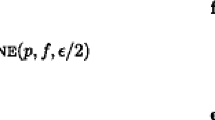Abstract
The authors consider the problem of choosing the capacity of arcs from a given set, which is important in flow distribution in multicommodity communication networks with constraint on flow delay time. Such problem is proved to be NP-hard. The algorithms for the approximate solution of the problem and results of their experimental comparison with exact algorithm based on generating a sequence of binary reflected Gray codes are given. It is noted that obtaining an exact solution is possible with the use of pseudopolynomial algorithms for the 0–1 multiple-choice knapsack problem.
Similar content being viewed by others
References
L. Kleinrock, Queueuing Systems, Vol. II, Computer Applications, John Wiley & Sons, New York (1976).
D. Bertsekas and R. Gallager, Data Networks, Prentice-Hall Inc., Englewood Cliffs (1992).
Yu. P. Zaichenko, “The problem of designing the structure of distributed computer networks,” Avtomatika, No. 4, 35–44 (1981).
E. Yu. Zaichenko, “A complex of models and algorithms for optimization of characteristics of networks with MPLS technology,” Systemni Doslidzh. ta Inform. Tekhnologii, No. 4, 58–71 (2007).
O. M. Trofymchuk and V. A. Vasyanin, “Simulation of packing, distribution and routing of small-size discrete flows in a multicommodity network,” J. of Autom. and Inform. Sci., Vol. 47, Iss. 7, 15–30 (2015).
M. R. Garey and D. S. Johnson, Computers and Intractability: A Guide to the Theory of NP-Completeness, W.H. Freeman & Co., New York (1979).
R. M. Karp, “Reducibility among combinatorial problems,” in: R. E. Miller and J. W. Thatcher (eds.), Complexity of Computer Computations, Proc. Symp. on the Complexity of Computer Computations, IBM Thomas J. Watson Research Center, Plenum Press, Yorktown Heights, New York (1972), pp. 85–103.
V. S. Mikhalevich and N. Z. Shor, “Numerical solutions of multiple-choice problems by the method of sequential analysis of variants,” Scientific and Methodical Materials of the Economic-Mathematical Seminar [in Russian], Issue 1, Rotaprint AN USSR, LEMI, Moscow (1962), pp. 15–42.
V. S. Mikhalevich, “Sequential optimization algorithms and their application,” Pt. I, Cybernetics, Vol. 1, No. 1, 44–55 (1965); Pt. II Cybernetics, Vol. 1, No. 2, 87–92 (1965).
V. L. Volkovich and A. F. Voloshin, “A scheme of the method of sequential analysis and sifting of variants,” Cybernetics, Vol. 14, No. 4, 585–593 (1978).
V. S. Mikhalevich, V. L. Volkovich, A. F. Voloshin, and Yu. M. Pozdnyakov, “Algorithms for sequential analysis and fathoming in discrete optimization problems,” Cybernetics, Vol. 16, No. 3, 389–399 (1980).
S. Martelo and P. Toth, Knapsack Problems: Algorithms and Computer Implementations, Wiley, Chichester (1990).
H. Kellerer, U. Pferschy, and D. Pisinger, Knapsack Problems, Springer-Verlag, Berlin–Heidelberg (2004).
M. S. Bansal and V. Ch. Venkaiah, “Improved fully polynomial time approximation scheme for the 0–1 multiple-choice knapsack problem,” Technical Report Number: IIIT-H/TR/2004/003, IIIT, Hyderabad, India (2004).
B. Suri, U. D. Bordoloi, and P. Eles, “A scalable GPU-based approach to accelerate the multiple-choice knapsack problem,” in: Design, Automation & Test in Europe Conference & Exhibition (DATE), 12–16 March 2012, IEEE, Dresden (2012). https://doi.org/10.1109/DATE.2012.6176665.
D. Rhee, Faster Fully Polynomial Approximation Schemes for Knapsack Problems, Massachusetts Institute of Technology Operations Research Center, Boston (2015). URL: http://hdl.handle.net/1721.1/98564.
E. M. Bednarczuk, J. Miroforidis, and P. Pyzel, “A multi-criteria approach to approximate solution of multiple-choice knapsack problem,” Computational Optimization and Applications, Vol. 70, Iss. 3, 889–910 (2018).
J. R. Bitner, G. Ehrlich, and E. M. Reingold, “Efficient generation of the binary reflected Gray code and its applications,” Comm. ACM, Vol. 19, Iss. 9, 517–521 (1976).
D. E. Knuth, The Art of Computer Programming, Vol. 4A, Combinatorial Algorithms, Part 1, Addison Wesley Longman, Boston (2011).
J. O. Cerdeira and P. Barcia, “When is a 0–1 knapsack a matroid?” Portugaliae Mathematica, No. 52, 475–480 (1995).
Author information
Authors and Affiliations
Corresponding author
Additional information
Translated from Kibernetika i Sistemnyi Analiz, No. 4, July–August, 2019, pp. 50–60.
Rights and permissions
About this article
Cite this article
Trofymchuk, O.M., Vasyanin, V.A. Choosing the Capacity of Arcs with Constraint on Flow Delay Time. Cybern Syst Anal 55, 561–569 (2019). https://doi.org/10.1007/s10559-019-00165-0
Received:
Published:
Issue Date:
DOI: https://doi.org/10.1007/s10559-019-00165-0




